Solid Biofuels
Humans have been using solid biofuels for heat and for cooking since dawn of civilization (Solid biofuels in form of firewood/fuelwood has been in use since the dawn of civilization. Wood, sawdust, leaves can all constitute biofuels (Ref: biofuel.org, UK ).
Processing of Solid biofuels: Many of the biomass sources for solid biofuels are already in convenient form for combustion. A few others like sawdust and wood needs compacting, sometimes along with a binding agent so that it is easier to store, transport and use this biofuel. Pellets or briquettes are common forms of such densified biomass.
Firewood
Firewood is any wooden material gathered and consumed for fuel. It is not processed and generally has a ‘log’ appearance. Most firewood requires splitting. This helps in seasoning by exposing more surface area. More than 3/4th of rural households in India depend on firewood and chips for cooking stoves. Green (unseasoned) firewood may weigh 70 to 100 percent more moisture than seasoned wood. Typically, seasoned (dry) wood has 20% to 25% moisture content. Heating pattern and efficiency of wood is subject to moisture content. (Ref: Wikipedia)
Gap between consumption and sustainable fuel production has been increasing (Ref: Report on Bioenergy Resource Status in India). The demand for firewood remains five times more than the supply from forests. Rural Indian women from poor families trudge long distances to search for scraps of firewood. (Ref : Indian Stove Programme, Bhaskar Sinha)
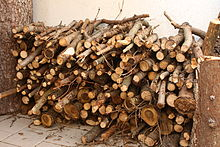
Ref : Wikipedia
Charcoal
Charcoal is produced from biomass resources like fuelwood by carbonization and is world’s most significant biofuel. It is a convenient form of fuel that can be transported long distance. Compared to fuelwood, charcoal produces much reduced emissions in cook stoves. In simple charcoal-making by products of the process (tar and gas) are often not utilized, creating pollution of the soil, water, and air. Their utilization would help reduce energy loss, increase the efficiency, and eliminate pollution. Methanol and acetic acid were byproducts of charcoal manufacture before advent of petroleum. (Ref : Yadwad et al. 2012 IJERT )
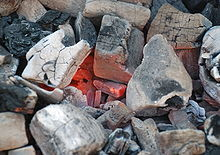
Ref : Wikipedia
Briquettes/ Pellets
Pressure heat and binding agents are used to densify loose biomass material into compact composites of different sizes. In developed country like USA, these pellets are popular fuel used in stoves and boilers. Perennial grasses can also be converted into pellets.
(Ref : Mahatma Gandhi Institute of Rural Industrialization, Pennysulvania state university – college of agriculture)
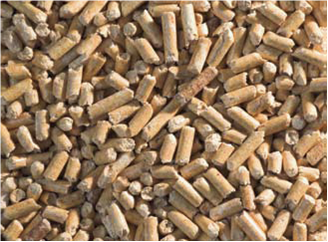
Image source: http://pubs.cas.psu.edu/freepubs/pdfs/uc203.pdf
Pellets are prepared using multiple steps such as feedstock grinding, extrusion, cooling. Some steps like moisture control, extortion may need research for process optimization while utilizing new biomass sources.
Pellets are a superior fuel over raw biomass due to energy density and ease of handling. Ideally the pellets should have specific ash content which restricts use of wood as the only ideal source. Special stoves (biomass stoves) are therefore required for pellets prepared from other biomass.
Fuel standardization, government interventions including incentives, regulations of efficiencies would help the technology of biomass stoves further. (Ref: Biomass magazine). ECS pellets made from novel combination of waste paper and coal have been useful for rural populations of Zambia addressing problems of deforestation, soot and pollution (Ref : climatesolver.org).
Improved cookstoves
Hazards associated with direct combustion of raw solid biomass: Although known to cause lesser emission of Carbon – di – oxide, raw biomass emits soot, smoke and many pollutants, particulates like dioxins, polycyclic aromatic hydrocarbons. The problem gets compounded if there is no proper ventilation. These can be hazardous for humans and animals.
Hoping to reduce utilization of firewood, government of India launched a programme National Programme on Improved Chulhas in 1983. The objective was to disseminate improved clay, mud stoves (fixed) and metal stoves (portable) which are fuel efficient and reduce air pollution. The programme also aimed at reducing drudgery for rural women, helping afforestation and generating local employment. Along with control of air pollution via installation of chimneys the programme helped in creating awareness for imporved cookstoves. (Ref : Indian stove programme, Bhaskar Sinha).
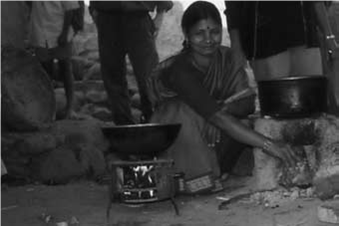
Ref : Indian stove programme, Bhaskar Sinha
In the year 2009 ministry of renewable energy, GOI launched a special initiative National Biomass Cookstove Initiative (NBCI) to promote improved cookstoves and their research. (Ref : MNRE websites). Under this programme several initiatives were taken viz. testing of improved cookstoves, approval and listing of approved models, demonstration projects and financial support for research and development.
Today, many innovative models of improved cookstoves are available in India such as Sarai cooking device developed by Appropriate Rural technology institute/Samuchit envirotech pvt ltd (Ref : website)
New innovative technologies are also being used in designing eco friendly and efficient cookstoves. A few examples include Oorja cookstove ( Ref First energy) using agricultural residues like peanut husks. Pressure cooker like device, Serai developed by Samuchit envirotech. Such devises are suitable for urban life styles as well and reduce dependence on LPG.
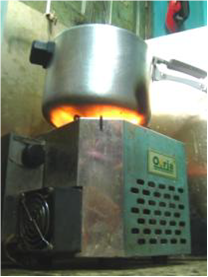
Oorja Gas stove, Ref : Awma events
Solid biofuels have also been helpful in providing employment opportunities, especially for self – help women groups.(Ref: Swayam Shikshan Prayog).
Solid biofuels for biopower : Biomass for Electricity Generation
Direct Firing of Solid biomass : Many power plants burn the feedstock directly and produce steam which run turbines to generate electricity. Part of the steam can also be used to generate heat its termed as CHP (Combined Heat and Power Facilities).
CoFiring : Coal firing supplemented with biomass feedstock in boilers to lower Sulphur di oxide emissions.
Integrated Gasification Combined Cycle (IGCC) - Here, the thermal gas from biomass is used to fire a gas turbine, and steam generated in a heat recovery boiler on the turbine exhaust is used to generate more electricity in a steam turbine. (Ref : Yadwad et al. 2012 IJERT)
